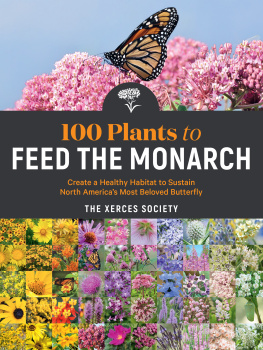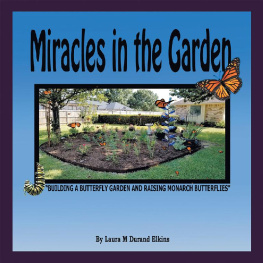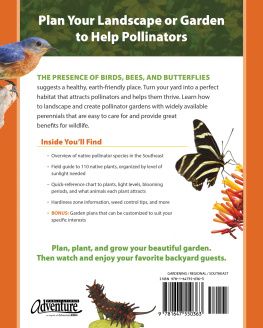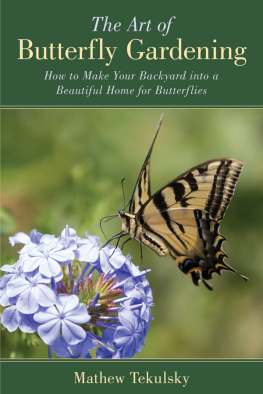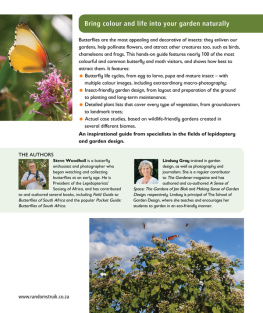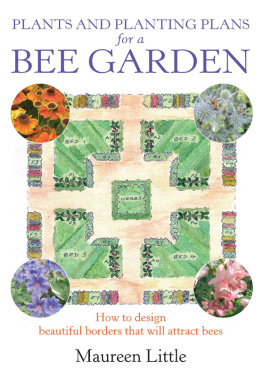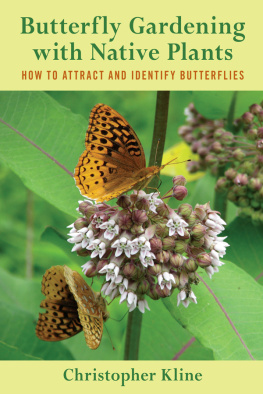
A variegated fritillary (Euptoieta claudia) rests on coreopsis, a plant commonly used in gardens.
Gardening for Butterflies
How you can attract and protect beautiful, beneficial insects
the xerces society
Scott Hoffman Black | Brianna Borders | Candace Fallon | Eric Lee-Mder | Matthew Shepherd
foreword by robert michael pyle
Timber Press
Portland, Oregon
Contents
FOREWORD
I am often asked why a butterfly guy such as I resides in what is arguably one of the worst locations to be found for butterflies. Well, its true, I do: the rain forest of the Maritime Northwest is among the least conducive places for both diversity and abundance of butterflies. There are good reasons for that, and also for why I live hereamong them, the chance to do original fieldwork in a region largely ignored by naturalists on account of its very subtlety. Another thing that keeps me here is how much one comes to appreciate each and every butterfly, a sense more difficult to maintain in the teeming tropics. Most salient to the present book is this: through judicious gardening, almost any precinct can be made more friendly for butterflieseven this one.
Somehow the question with which I began loses its barb when I am entranced by a gorgeous big female Clodius parnassian, smoky white with jet and ruby spots, cruising my garden in search of nectar and the wild bleeding hearts of my woods on which to deposit her eggs. I dont feel bad about where I live as I watch woodland skippers by the score and half a dozen mylitta crescents queueing together like so many animated gold nuggets around the Douglas asters of late summer; nor wish to move elsewhere when the several species of swallowtails sail about the old farmyard lilacs and rhododendrons. And, as with almost anywhere, certain kinds of butterflies are well adapted even here, such as linen-like margined whites and ice-blue echo azures. By the plants I choose to grow, I can help make sure these butterflies and others proliferate.
The authors of Gardening for Butterflies, all consummate professionals in the field of pollinator conservation, have taken this beloved practice into new territory. First introducing butterflies and moths as the animals they are, then placing them into an ecological context, they set the stage for successful backyard (or back forty) management on behalf of the bright wings of summer. In delightfully readable yet authoritative prose, they take the gardener and the butterfly lover each by the hand and lead them into territory they may profitably share. Discussing the best plants for each region and garden type, they help the reader make suitable decisions and designs well before the seed catalogues arrive for spring. It can be even more fun planning the butterfly garden than actually planting it... at least until the invited guests show up! Then all the effort becomes worthwhile, and you can sit back, enjoy the added color and life in your own home habitat, and thank these authors.
The habitat of home: thats what all wildlife gardens are about, and butterfly gardens are one of the most responsive kindsthe nectar and larval host plants responsive to your care and good choices for where you live, and the butterflies responsive, in turn, to them. By nurturing, enriching, and diversifying your own habitat of home, you are taking part in real butterfly conservationa very needful activity these days. You might not influence many endangered species directly, but you can surely help keep the more common and widespread kinds from getting that way. If this claim seems overblown, consider the fact that the monarch, our tri-national icon as North American butterflies go, is as of this writing in early 2015 under consideration for federal listing under the Endangered Species Act. Its future depends in no small part on landscape decisions, small and large, to be taken across southern Canada and the United States. Butterfly gardeners will play a distinct role in bringing back the monarch, just as they may in keeping great spangled fritillaries abundant for the children to chase and marvel at in days and years to come.
When Xerces appeared on the scene in 1971, I was much inspired by L. Hugh Newmans British book Create a Butterfly Garden. Now that the Society is thriving, it is very exciting to see it produce with Timber Press that pioneering books state-of-the-art successor. It will prove excellent company for aspiring butterfly gardeners, whether advanced or beginner.
Perhaps youre beginning with a cottage garden stocked with traditional ornamentals. Youd like to keep your zinnias (great for painted ladies!) but augment them with native plants coevolved with local insects. Or lets say you have a vegetable plot free of weeds and pests but equally innocent of butterflies, which you miss. Or maybe you share your yard with bluegrass turf and know you could do better. No matter your starting point, this essential and welcome book will help you bring about the garden you desirefor the butterflies, for yourself, and for the earth. If I can do it here in the temperate rain forest, you surely can too, wherever you live!
Robert Michael Pyle
Grays River, Washington
PREFACE
Butterfly gardeners can change the world
A couple of us writing this book grew up during the last gasp of the American muscle car. We have teenage memories of rocketing in Plymouth Barracudas and Chevy Novas down old country roads in the Midwest and the Great Plains. Even a short drive back then resulted in hundreds of dead bugs splattered across the grille, so we were always washing those cars. Returning to our teenage haunts today with a few gray hairs, vastly more fuel-efficient cars, and the lens of professional conservationists, we are awestruck by the lack of bugs. Drive across the entire state of North Dakota, Nebraska, or Iowa now, and your car will be practically spotless when you get to the other side. Animals, including insects, are disappearing.
A global assessment of wildlife populations in 2014 released by the World Wide Fund for Nature and the Zoological Society of London (ZSL) found that the sheer number of vertebrates on earth had declined by more than 50 percent since 1970. While the ZSL report did not assess insect populations, irrefutable evidence of their decline and clear examples of insect extinctions can be found. Many of the rare insects have always been rare, but now once-common insects are becoming rare as well. The most striking example of this is the iconic monarch butterfly, whose population has declined by 80 percent across North America since monitoring efforts began in the mid-1990s.
Loss and degradation of habitat is driving this disappearing act. Urban landscapes divide up, pave over, and fragment formerly green spaces. Agriculture favors fewer types of crops, leaves fewer edges unplowed and untrampled, and tolerates ever fewer pests. The wild places that remain bear the indignities of invasive species, climate uncertainties, and hardscrabble resource extraction such as mining and logging. The net result is that 7 billion humans have finally created a fully human-dominated world.
Despite the biodiversity crisis unfolding in real time all around us, we believe that butterflies and other animals can have a secure future. However, such a future will require reconciliation between the human environment and a more natural one. Policies that could accelerate such a reconciliation are desperately needed. At the same time, as individuals we cannot simply stand by and do nothing while we wait for those policies. At least in the case of butterflies, every one of us who gardens has the potential to change the world.
Next page

